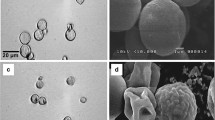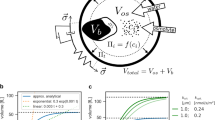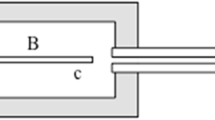Summary
-
1.
A method was developed, by which it was possible to measure the volume of an internodal cell ofNitella flexilis as a function of interior pressure. For this to be done, the cell wall tube, closed at one end with the natural septum, was filled with mercury and pressure was applied to the mercury. The accompanying change in volume of the cell wall tube was measured simultaneously with the applied pressure.
-
2.
The time course of volume change of the cell in response to change in interior pressure indicates that cell wall elasticity is composed of at least two components, an instantaneous elastic component, and a retarded elastic component with a retardation time of about 1–5 minutes.
-
3.
Both instantaneous and slow processes in volume change vary according to the level of the pressure applied and to the direction of the pressure change.
-
4.
The volume of the cell can be kept at different values, under the same interior pressure, according to the direction of the pressure change; in other words, the interior pressure-volume relation shows a hysteresis.
-
5.
Taking into consideration the hysteresis character in mechanical properties of the cell wall, the osmotic pressure, turgor pressure and suction force (diffusion pressure deficit) of an internodal cell ofNitella flexilis was illustrated in relation to the cell volume in an osmotic diagram after Höfler. A characteristic of the diagram is that the cell can have different turgor pressures and suction forces within certain limits even though the volume of the cell is the same.
-
6.
The length of the living cell was measured under different turgor pressures. The facts that the pressure-cell length relation showed also a distinct hysteresis character and that the wall elasticity of the living cells was in the same order as that of the cells filled with mercury, indicate that the results obtained with cell wall tubes were also true of the living cells.
-
7.
The cell wall of the internodal cell ofNitella flexilis extends more in the direction of transverse axis of the cell than in the direction of longitudinal axis under the influence of turgor pressure. When equal tensions in the respective direction are considered, however, the cell wall extends to the same extent in each direction.
-
8.
The uniaxial longitudinal tension, caused by loading, elongates the cell about 3–4 times more than does the longitudinal component of the equivalent tension caused by turgor pressure.
Similar content being viewed by others
Literature
Green, P. B., 1958: Structural characteristics of developingNitella internodal cell walls. J. Biophys. Biochem. Cytol.4, 505.
—, 1960: Multinet growth in the cell wall ofNitella. J. Biophys. Biochem. Cytol.7, 289.
Höfler, K., 1920: Ein Schema für die osmotische Leistung der Pflanzenzellen. Ber. dtsch. bot. Ges.38, 288.
Houwink, A. L., and P. A. Roelofsen, 1954: Fibrillar architecture of growing plant cell walls. Acta Bot. Neerlandica3, 385.
Kamiya, N., and M. Tazawa, 1956: Studies on water permeability of a single plant cell by means of transcellular osmosis. Protoplasma46, 394.
Kamiya, N., M. Tazwa, and T. Takata, 1962: Water permeability of the cell wall inNitella. Plant and Cell Physiol3, 285.
Probine, M. C., and R. D. Preston, 1961: Cell growth and the structure and mechanical properties of the wall in internodal cells ofNitella opaca. I. Wall structure and growth. J. Exper. Bot.12, 261.
— —, 1962: Cell growth and the structure and mechanical properties of the wall in internodal cells ofNitella opaca. II. Mechanical properties of the walls. J. Exper. Bot.13, 111.
Roelofsen, P. A., and A. L. Houwink, 1953: Architecture and growth of the primary cell wall in some plant hairs and in thePhycomyces sporangiophore. Acta Bot. Neerlandica2, 218.
Stow, I., 1936: On the osmotic work of a plant cell and its elasticity. Bot. and Zool.4, 1336 (Japanese).
Tamiya, H., 1938: Zur Theorie der Turgordrehung und über den funktionellen Zusammenhang zwischen den einzelnen osmotischen Zustandsgrößen. Cytologia8, 542.
Tazawa, M., 1957: Neue Methode zur Messung des osmotischen Wertes einer Zelle. Protoplasma48, 342.
Author information
Authors and Affiliations
Additional information
Herrn Prof. Dr. Karl Höfler zum 70. Geburtstag gewidmet.
This work has been supported partly by a Grant for Fundamental Scientific Research from the Ministry of Education.
Rights and permissions
About this article
Cite this article
Kamiya, N., Tazawa, M. & Takata, T. The relation of turgor pressure to cell volume inNitella with special reference to mechanical properties of the cell wall. Protoplasma 57, 501–521 (1963). https://doi.org/10.1007/BF01252073
Received:
Issue Date:
DOI: https://doi.org/10.1007/BF01252073




